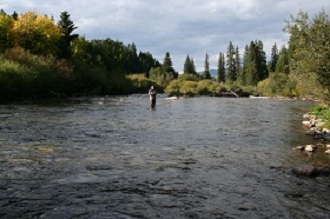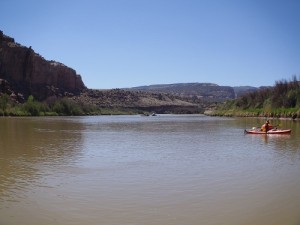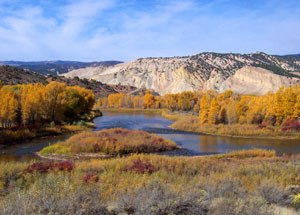For over 100 years, the Relief Ditch diversion on the Gunnison River has been a headache for local landowners and irrigators and a major obstacle for boaters and fish. The diversion dam, which is used to divert water for farms east of Delta, was washed out almost every year with high spring runoff flows, and then reconstructed annually by the irrigation company using bulldozers in the river channel to push up cobble creating a temporary dam. The dam created several problems, including erosion of nearby river banks, an unnatural buildup of sediment downstream, and a migration barrier to fish. It also poses a safety hazard to boaters.
In November 2012, Trout Unlimited, the Relief Ditch Irrigation Company, BLM, and other stakeholders broke ground on a construction project to modernize the Relief Ditch diversion. The project will improve water delivery for irrigators while benefiting trout, Flannelmouth sucker, Bluehead sucker, and Roundtail chub as well as wildlife habitat in the BLM’s Gunnison Gorge National Conservation Area.
“TU is identifying opportunities like this in Colorado to upgrade aging infrastructure in a way that benefits both ag producers and fish and wildlife,” said Cary Denison, project leader for TU. “We’re very excited about the opportunity to work with the irrigators to improve the diversion.”
Gunnison Gorge Anglers, the local Trout Unlimited chapter, has led the effort to replace the push-up dam with a permanent low head diversion structure and a grade control structure—improvements that will remove the fish barrier and hazard to boaters and expand habitat for several native fish. TU and partners have installed a new headgate that will reduce maintenance and expense for irrigators. By measuring the diversion at the headgate, it will also allow irrigators to avoid drawing more water than they need from the river –helping to bolster flows. TU has also restored the eroded riverbanks near the project with native plantings and erosion-resistant fill.
Chapter President Marshall Pendergrass explained, "This project started over three years ago from the ideas of one local TU chapter member and has become the model for working with many local, state and federal agencies to complete a major project that benefits so many water users. We are proud to be coordinating agents of this significant milestone for the Gunnison River cold water fisheries."
Final project construction was completed in March 2013 at a total cost of over $750,000.
“Many rivers and streams in the Colorado River Basin have become fragmented over the years, preventing fish movement and degrading habitat,” said Denison. “We’re working with local partners on win-win projects like this one that both open up river habitat and address infrastructure problems.”
“We’ve enjoyed working with Trout Unlimited on this project," said Mel Frazier of Relief Ditch Irrigation Company, "and look forward to the improvements to the system.”












